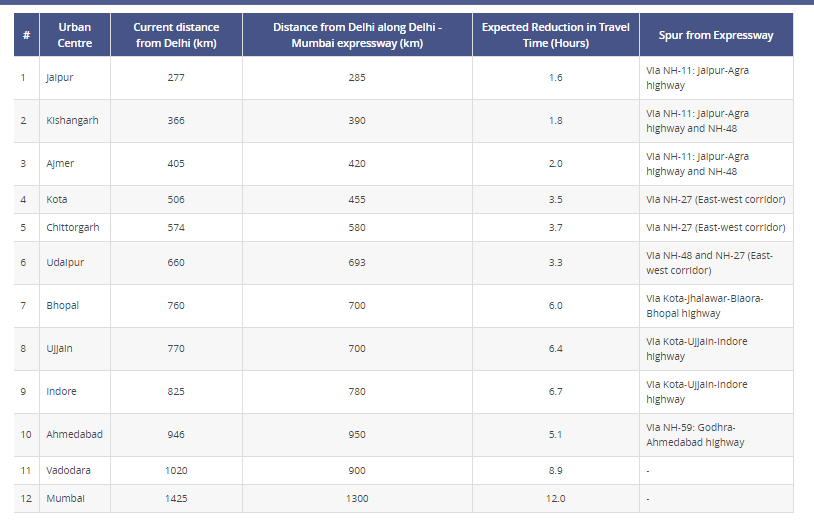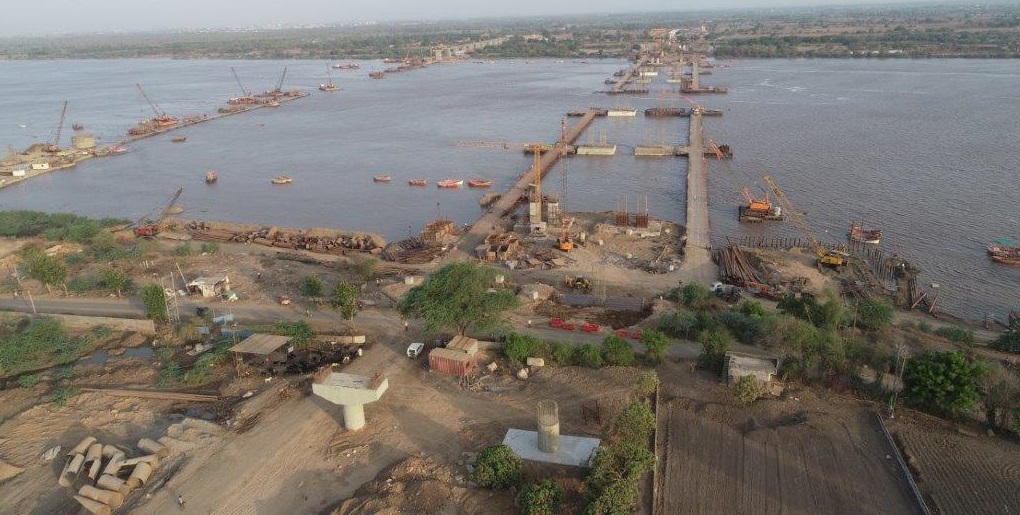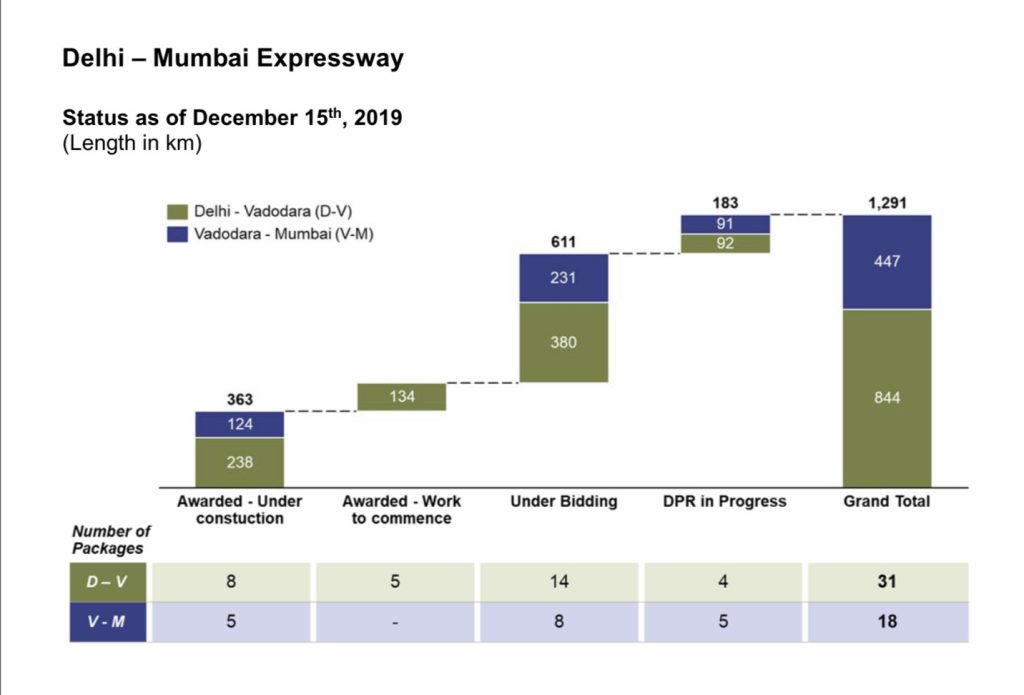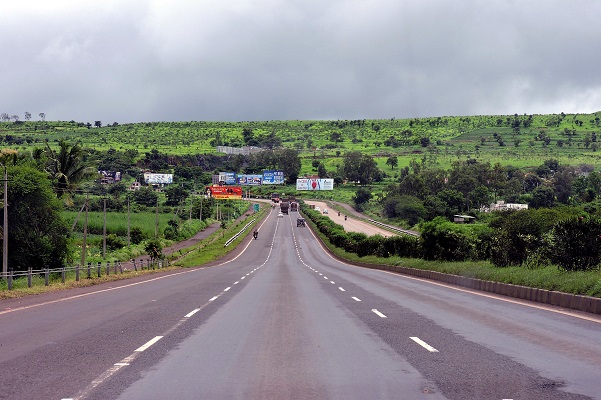For the Bharatiya Janata Party (BJP)-led National Democratic Alliance (NDA) government, since 2014, providing major impetus to infrastructure development has been a key thrust area.
Since 2014, highway construction has also witnessed an upward trend. From 11 kilometres constructed per day in 2010-11, the number increased to 17 km in 2015-16, 23 km in 2016-17, 27 km in 2017-18, and 29.65 km in 2018-19.
Last December, the government unveiled Rs 103 lakh crore National Infrastructure Pipeline (NIP) comprising of over 6,500 greenfield and brownfield infrastructure projects that will be identified and executed over the next five years. Almost 20 per cent of the NIP (little more than Rs 20 lakh crore) was earmarked for roads alone.
The target is to add 50 per cent total length to the existing National Highways, with 12x more Expressways constructed. Given that the Bharatmala project has already identified some ambitious projects, the target looks attainable.
Bharatmala Pariyojana
In 2017, the Union government announced its flagship road development project- Bharatmala Pariyojana. The project envisages a macro and corridor-based approach to road development catering to expansion as well as plugging of the existing infrastructure gaps.
Bharatmala Pariyojana, with a committed first phase funding of Rs 535,000 crore for the National Highway sector, is audacious in its ambition and massive in its scale. It aims to enhance the movement of freight and passenger traffic across the country by addressing critical gaps in infrastructure. The program conceptualises development of economic corridors, inter corridors, feeder routes, international connectivity roads, coastal and port connectivity roads and other green-field expressways.
The first phase of implementation is planned for a five-year period from 2017-18 to 2021-22, and will target development of 24,800 km of road network apart from completion of 10,000 km of ongoing road works under NHDP. Phase 1 is expected to be implemented at a projected total cost of Rs 5,35,000 crore.
The government has also identified 26,200 km of Economic Corridors with high levels of freight traffic with development of around 9,000 km of Economic Corridors is targeted under Phase 1.
Apart from these, the programme covers improvements/construction works pertaining to the National Corridor (Golden Quadrilateral and NS-EW), Inter-Corridors (8,000 km), Feeder Roads (7,500 km), Border Roads (3,300 km), Coastal & Port Connectivity Roads (3,305 km) and Expressways (1,837 km). Ring roads are proposed to be developed around 28 major cities across the country under Bharatmala Pariyojana.
Delhi-Mumbai Expressway
The most prominent project of the Bharatmala Pariyojana programme is the under-construction Delhi-Mumbai Expressway. At nearly 1,320 km, it will be India’s longest expressway and will reduce travel time between Delhi and Mumbai from the 24 hours to 13 hours. The new highway is being built at an estimated cost of Rs 103,000 crore. The highway will start near Gurugram at Sohna and terminate at Mumbai. The expressway will cut the distance between the national and financial capital of India by 280 km.
Currently, Delhi and Mumbai are connected by NH-48 which terminates at Chennai. However, the highway is already overused resulting in routine traffic congestion, thus making it unviable for critical freight movement or smooth passenger movement.
A Smart Way To Beat High Land Costs For Building Highways
One of the other reasons for not upgrading this stretch was the cost. Passing through densely populated areas, expansion of NH-48 would have warranted the rehabilitation of a significant chunk of the population on either side. This also pushes the land acquisition cost upward, further adding to the complexity. These factors led the government to go for a greenfield alignment instead.
Going for a greenfield alignment saved the government around Rs 16,000 crore due to cheap land acquisition as the new expressway passes through socially and economically backward tribal areas of Rajasthan, Madhya Pradesh, Gujarat, Maharashtra and Haryana.
To put things in perspective, the land acquisition cost at the new stretch was Rs 80 lakh per acre. However, if the government had gone for the NH-48 alignment, which includes Delhi-Ahmedabad-Surat-Vadodara-Mumbai, the per-acre cost would have been Rs 6 crore.
Designed For 12 Lane Expansion and 120 kmph
The Delhi-Mumbai Expressway will have an eight-lane configuration, with a provision to expand to 12 lanes in the future. The design speed on this access-controlled expressway will be of 120 km/hour.
For the Delhi-Vadodara stretch of the expressway, the perpetual pavement design is being used, given the regions, it passes through.
However, for the Vadodara-Mumbai stretch, a rigid pavement design is being drawn up as it passes through rainfed areas to ensure comfort, travel quality, and a longer pavement life with a lower total cost.

The Economics Behind India’s Most Important Expressway
At an interval of 50 km, a network of 75 wayside amenities is also being planned. The amenities will include commercial spaces like motels for drivers, hotels for travellers, and other facilities that aid the smooth movement of traffic and freight.
These facilities will come up in the vicinity of important cities, as that will enable economic activity. In the future, these amenities will be supplemented by shopping centres, logistics parks, eateries, etc, as currently witnessed across some other highways in the country.
Also in the planning is a separate lane for electric vehicles. At a recent event, the Union Minister of Road Transport and Highways Nitin Gadkari proposed the idea of an electric lane on the expressway while urging private players to explore investment options alongside the government.
The government has also been vocal about involving private players for bio-CNG usage in vehicles. The minister added that the investments in bio-fuel could bring down crude imports by Rs 7 lakh crore.
The construction of the expressway will usher in a number of benefits for the population along the stretch.
Firstly, it will add to the employment prospects, given the number of people needed during the construction phase. Beyond that, people would be routinely employed for maintenance purposes. The expressway is expected to generate 50 lakh man-days worth of employment in the construction phase alone.
However, the bigger boost to employment will come from the amenities that will come up on either side of the expressway, especially in commercial spaces and shopping centres. Given these amenities will be located near the centres of economic activity, availability of labour will not be a problem and would, in turn, enable the socio-economic growth in the hinterlands of Rajasthan and Madhya Pradesh.

The expressway will also offer travellers and freight carriers an alternate route to the cities of Jaipur, Kota, Chittorgarh, Indore, Ujjain, Bhopal, Ahmedabad and Vadodara, cutting down the travel time and also decongesting the existing route on NH-48.
The Delhi-Mumbai Expressway must also be viewed in the context of freight and cargo movement.
Moving India: Delhi-Mumbai’s Big Leap In Logistics
In the National Capital Region (NCR), the second-half of 2019 saw tremendous growth in the logistics space in the Gurugram region, the area where the expressway originates from.
The availability of space-enabled small to medium-sized deals (20,000-100,000 square feet), allowing for leasing of spaces. Across NCR, the completion of more than 4 million sq/ft of logistics space was witnessed in the latter half of 2019 along with a rental appreciation of 2-6 per cent.
Mumbai, the other end of the expressway, also witnessed sustained logistic growth in the second half of 2019. E-commerce players enabled the majority of the leasing with the rental growth being stable.
While willing travellers will have the option to drive themselves between the two centres, it is the freight and cargo movement companies that are set to be the biggest beneficiaries. This will be because of the reduction in travel time of many cities from Delhi and Mumbai.
To put things in perspective, the expressway will reduce the distance between Kota and Delhi by 51 km and cut short the travel time by 3.5 hours. Between Bhopal and Delhi, the distance will be reduced by 60 km with a reduction in travel time of 6 hours. Between Ujjain and Delhi, the distance will be reduced by 70 km with a reduction in travel time of 6.4 hours.
The distance between Vadodara and Delhi will be reduced by 120 km, thus ushering in a reduction of 8.9 hours in travel time. Between Mumbai and Delhi, the reduction will be of more than 12 hours. Given that the expressway will be access-controlled, those cities falling farther from Delhi on the expressway will see a significant reduction in travel time.
Reduction in distance will reduce logistics costs in the neighbourhood of 8 to 9 per cent, thus ensuring saving of more than Rs 100,000 crore over the lifetime of the project. There will also be a reduction in fuel consumption, time spent, and distance covered which will have a positive impact on India’s crude imports bill.
The expressway must also be viewed in the context of the Western Dedicated Freight Corridor (WDFC). With the corridor operational, freight and cargo movement companies, especially third-party logistics companies and e-commerce players will have the flexibility of moving cargo at greater speeds, thus improving customer service and drive better sales numbers by virtue of faster deliveries. The regions connecting the expressway and the WDFC shall be indirect beneficiaries of both the projects.
Environmental considerations have also been factored in the construction and operational phase of the Delhi-Mumbai Expressway.

Cutting Distance, Time, and Carbon Dioxide Emissions
Firstly, the reduction in fuel consumption is estimated to be around 320 million litres of fuel per annum. If per litre emission is assumed to be 2.68 kilogram worth of carbon dioxide, this will alone cut down the emission by 857 million kilograms.
This is equivalent to the emissions by 944,296,428 pounds worth of coal burned, emissions from around 11,000 tanker trucks worth of petrol, emissions from more than the average energy used per annum by around 99,000 houses in the US, emissions from 1,984,136 barrels of oil consumed, and equal to the emissions by 109,295,114,376 smartphones charged, and all this in one year alone without factoring the use of electric vehicles.
Secondly, there is a plan for planting more than 1,000,000 trees on the new stretch. Also, a number of major bridges, minor bridges, and culverts are being planned on the new greenfield alignment to minimise the impact on water bodies. There is also a plan for rainwater harvesting facilities at every 500 metres to conserve water.
Lastly, the expressway could boost investment in renewable energy infrastructure. Apart from the proposed lane for electric vehicles, there are proposals to install solar lights at critical junctures, interchanges, exits, and toll plazas to ensure road safety and comfort.
Construction In Full Swing
Union Minister for Road Transport & Highways Nitin Gadkari, in an event recently, stated that work for 18 packages on the 1290-km-long access-controlled Delhi-Mumbai Expressway has been awarded and the road is expected to be completed in three years time.
“We have awarded work for 18 packages out of the 51 and the work has started on them. We hope to award contracts for the remaining packages also this year. We are making efforts to complete the project during our five-year tenure,” the minister was quoted.
The expressway is set to be completed by the end of 2022. By December 2019, 363 km of the stretch was already under construction, with 238 km of it being the Delhi-Vadodara stretch and the remaining being Vadodara-Mumbai. Contracts have been awarded for another 134 km on the Delhi-Vadodara stretch.
Bidding for contracts for 611 km stretch, with 231 km under the Vadodara-Mumbai stretch and the remaining under Delhi-Vadodara stretch is already underway.
Currently, the Delhi-Mumbai corridor witnesses traffic of around 80,000 PCU (passenger car equivalent) and is expected to increase to 100,000 PCUs by the time the expressway is operational.

Factoring in the growth of the logistics, freight movement on roads, EV development, WDFC, and the importance of the two cities as financial and political capitals, this Delhi-Mumbai stretch is indeed the most important expressway of modern India.


